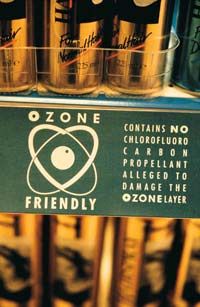The Danger and Prevention of Ozone Layer Depletion
When you think about ultraviolet light, do you think black lights? Black lights use harmless ultraviolet light, but the ultraviolet light that the ozone layer absorbs would be extremely dangerous if it came in contact with our skin. There are many different types of UV light, and their classification depends on their wavelengths. UV light comes in the following forms:
- UVA (between 320 and 400 nanometers): Ozone does not absorb UVA light.
- UVB (between 280 and 320 nanometers): This can be harmful to skin, and, thankfully, the ozone protects us from much of it. But even a healthy, "thick" ozone layer doesn't prevent all UVB from reaching the earth.
- UVC (less than 280 nanometers): The ozone layer prevents all UVC from reaching the earth's surface. That's a good thing because UVC would be very harmful to our ecosystems.
The UV intensity on the surface of the earth fluctuates from day to day and depends on where you live. These days it's easy to check on the local UV index, which tells you how intense the UV radiation is in your area. In the U.S., the UV index is calculated from various factors, including ozone measurements and local cloud-coverage predictions [source: EPA]. Meteorologists measure UV radiation in terms of its energy in an area over time, such as milliwatts per square centimeter per second. They express this in weather reports in numbers and colors.
Advertisement
- Low (Green) = 0-2
- Moderate (Yellow) = 3-5
- High (Orange) = 6-7
- Very High (Red) = 8-10
- Extreme (Purple) = 11 and higher
Even with the ozone layer, UVA and especially UVB light can penetrate it to cause these health problems for humans:
- Skin cancer: The American Cancer Society cites UV radiation as the primary cause of skin cancer [source: ACS]. When UV light damages DNA , it impairs its ability to control skin growth.
- Other skin problems: Overexposure to UV light can lead to skin effects that resemble premature aging, as well as skin lesions known as Actinic keratoses.
- Immune suppression: Evidence suggests that the body's immune system will begin to weaken as a result of too much UV light.
- Eye problems: Cataracts can develop from UV exposure, which essentially clouds sight and can lead to blindness.
Given that these risks exist even when the ozone layer absorbs about 98 percent of UV light, a future with an even thinner ozone layer is scary indeed. In the 1980s, this frightening prospect motivated the scientific community and policy makers of the world to address the issue of CFC production, which resulted in the 1987 Montreal Protocol. Policy makers from different industrialized countries signed this treaty as a pledge to reduce their CFC outputs. International Day for the Preservation of the Ozone Layer is celebrated each year on the anniversary date of the treaty, September 16th.
Efforts to find a replacement for CFCs have been somewhat successful. For instance, HCFCs (Hydrochlorofluorocarbons) can also potentially deplete ozone gas in the stratosphere, but not nearly to the extent of CFCs [source: UCS].
The efforts seem to be working. Reports show that by 2049, the ozone will recover to 1979 thickness, which is when scientists believe the hole began to form [source: Reuters]. Many scientists believe the Montreal Protocol is responsible for this joyous recovery.
To learn much more about the ozone and other related subjects, explore the links below.
Related Articles
- How Ozone Pollution Works
- Can we plug the hole in the ozone layer?
- How can the ozone be both good and bad?
- How the Sun Works
More Great Links
Sources
- ACS. "UV Radiation & Cancer." American Cancer Society. 2006. (April 17, 2008)http://www.cancer.org/downloads/PRO/UV.pdf
- Chemical Heritage."Making and Destroying Ozone." Chemical Heritage. 2001. (April 17, 2008)http://www.chemheritage.org/educationalservices/faces/env/readings/O3end.htm
- EPA. "Health Effects of UV Radiation." Environmental Protection Agency. (April 17, 2008)http://www.epa.gov/sunwise/uvandhealth.html
- EPA. "How is the UV Index Calculated?" Environmental Protection Agency. Jan. 3, 2008 (April 21, 2008)http://epa.gov/sunwise/uvcalc.html
- EPA. "Ozone Depletion Glossary." Environmental Protection Agency. Mar. 14, 2008. (April 17, 2008)http://www.epa.gov/ozone/defns.html
- Fahey, D.W. "Scientific Assessment of Ozone Depletion: Twenty Questions About the Ozone Layer: 2006 Update." World Meteorological Organization, March 2007. (April 15, 2008)http://www.esrl.noaa.gov/csd/assessments/2006/chapters/twentyquestions.pdf
- NASA. "TOMS - EP." National Aeronautics Space Administration. Mar. 6, 2008. (April 17, 2008)http://nasascience.nasa.gov/missions/toms
- NASA. "What is a Dobson Unit?" National Aeronautics Space Administration Feb. 1, 2008. (April 17, 2008)http://toms.gsfc.nasa.gov/dobson.html
- NOAA. "Ozonesonde." National Oceanic and Atmosphereic Administration. Mar. 20, 2008. (April 17, 2008)http://www.ozonelayer.noaa.gov/action/ozonesonde.htm
- "ozonosphere." Encyclopaedia Britannica. (April 17, 2008)http://www.britannica.com/eb/article-9057880/ozonosphere
- Reuters. "Ozone Layer Healing, but More Slowly Than Hoped." The Washington Post. Aug. 19, 2006.
- Sparling, Brien. "Ultraviolet Radiation." National Aeronautics Space Administration. Mar. 30, 2001. (April 17, 2008)http://www.nas.nasa.gov/About/Education/Ozone/radiation.html
- Spector, Laura. "R.I.P. TOMS: NASA Ozone Instrument Laid to Rest After Three Decades." National Aeronautics Space Administration. Aug. 15, 2007. (April 17, 2008)http://www.nasa.gov/centers/goddard/news/topstory/2007/toms_end.html
- The Nobel Foundation. "The Nobel Prize in Chemistry 1995: Press Release." The Nobel Foundation. Oct. 11, 1995.
- UCS. "Global Warming: Frequently Asked Questions about Ozone Deletion and the Ozone Hole." Union of Concerned Scientists. Aug. 10, 2005. (April 17, 2008)http://www.ucsusa.org/global_warming/science/faq-about-ozone-depletion-and-the-ozone-hole.html
